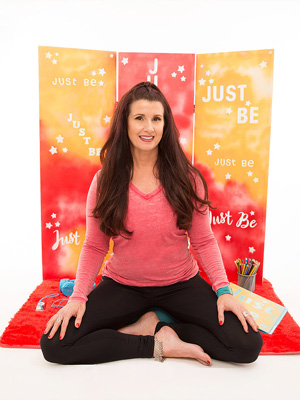As the school year winds down we’re looking at the ways students
and teachers are changing the face of classroom learning.
Finding The Calm
Bill Meyer is helping teachers everywhere bring meditation into the classroom.

Though always a part of his personal life, meditation wasn’t something that Bill Meyer shared with his students. The New York-based high school history, economics, and humanities teacher was intrigued, however, when in 2012 one of his students approached him with a request.
“He knew that I meditated and he asked me to be a part of a research study about meditation,” says Meyer, who just released his first book, “Three Breaths and Begin: A Guide to Meditation in the Classroom. “Once it was done the students wanted to continue the study, and from that we created the idea of the Meditation Club, which still meets today.”
Inspired by the students’ interest, Meyer began to bring meditation techniques into his own classroom, eventually working with other teachers in his school and around the country to find ways to reap the benefits of the practice for students of all ages. “The students were the ones who gave me the courage to bring that into the classroom,” says Meyer. “You could see how receptive the students were to it. There is a lot asked of them and they don’t always have the tools to cope with it.”
Not that it’s always easy. “Students can be a tough audience,” he says, laughing. But their potential to accept and understand is limitless. “Adults are more patient, and sometimes more polite, in trying something like meditation, but they don’t always have the depth or capacity to go where students can go,” says Meyer. The key to success, he explains, is to keep it simple, something he imparts to other teachers looking to introduce meditation into their school. “I try to keep it very simple and ground it in the body, and sensations of the body, and then move to visual,” he says. “I always lead the mediations, this makes it more accessible. A long, silent meditation is about as foreign to a student as you can get.”
Meyer also suggests giving students something to focus on. “They should have a specific experience or image to latch on to, to think more about,” he says. “It can be connected to their heart or to a research topic. Then they can really marinate on those experiences. It never fails to surprise me that days later the processing really goes to another level.” The classroom setting, surprisingly, is fertile ground for the benefits of meditation, with the physical presence of others bringing what he calls “a collective power,” and building on the relational component of group learning.
Though Meyer started with high schoolers, he sees the possibilities as endless for all students – even doing simple meditations (“It can be as easy as just taking three breaths.”) with his two-and-a-half year old son. “It’s amazing how expansive their minds are,” he says of younger students. “They will drop in so fast and the things that they will say at the end are mind blowing… The way they process their feelings, anxieties and worries.” Meyer even has a children’s book, “Big Breath: A Guided Meditation for Kids” due out in August.
With the release of the book, Meyer is hoping to share his experiences with other parents and educators so they too can bring new options to the table for their own children. Says Meyer, “The job of educators is to keep students as open as possible, as long as possible.”
Meyer’s Tips
- Begin together. Meyer advises anyone looking to bring meditation to students to try it themselves first. “You can’t offer something you yourself don’t have,” he says. And the learning curve can be helpful. “There’s a benefit to being new to meditation. You’re attuned to the challenges.
- Start slow. As he mentioned before, Meyer likes to lead the meditations himself, but says starting can be as simple as a few breaths before a discussion or a moment of silence as class begins.
- Think about timing. His own introduction for students came right before a school break, as he replaced the usual movie-watching with a meditation discussion, a decision that ended up being repeated throughout the year by student request. “It’s all about finding the moments,” he says.
For more information on Meyer and his books, visit billpmeyer.com.
The Secrets To Success
How to survive and thrive in your educational journey? Here are some tips from the graduating seniors of Palmetto Senior High School…
“Prepare yourself for an insane amount of growth- or at least try to- and understand that you will never be the same as you once were. Don’t worry so much about finding your passion, as everyone tells you, but find a couple things that you really enjoy doing, and do more with them. You are capable of more than you think you are, so find that little push to keep you going.”
Julia Damski, Georgetown University – Walsh School of Foreign Service (after a gap year in Germany with CBYX)
“Focus less on doing stuff for college and more on just following your passions. Usually these two go hand and hand and activities seem a lot more genuine and are more enjoyable when you are passionate about them.”
Ryan Rosner, Duke University
“Don’t be afraid to try things that are out of your comfort zone, because those are times when you often learn the most. Ask for help when you need it, because Palmetto’s support system is amazing and will always try to find ways to provide assistance. Open yourself up to the world and it will open itself up to you in return.”
Ava Lemos, Tulane Honors Program
“Take the time to ponder over the little things that occur in your life. The big things are hard to miss, but when you focus on the little things, they have the power to reveal aspects of life that you may have not noticed shape you. Not only does it make killer college essays, but it helps you reflect.”
Wiljeen Paul, Pomona College
“Don’t spread yourself too thin and give yourself a course load you know you can’t handle, but push yourself. Do it all. Go to the high school football games, join a club, maybe two, participate in panther prowl – do it all! You will have so many memories to look back on and will meet so many new and interesting people.”
Katherine Diez, University of Southern California
Mindfulness at Home
5 Tips from Psychotherapist and Mindfulness Teacher Nikki Levine

Tip #1
Mindful Breathing. First, pick an activity that you do daily such as driving, answering the phone, or opening an email. Once you have chosen the activity, sprinkle a bit of mindfulness onto it by taking three mindful breaths before you get in to your car, answer your phone or open an email. Mindful breathing is simply bringing all of your awareness and attention onto the breath, while extending the exhale a bit longer than your inhale. You can close your eyes, rest your hands on your thighs, and relax your shoulders back and down to get the full benefit of mindful breathing. Do this three-breath mindfulness practice once a day for one week and see what happens. Notice the thoughts that come through your mind without trying to change them or make them go away. Just notice and stay curious. And definitely don’t beat yourself up if you forget, because this is a practice… and takes practice.
Tip #2
The Handjam. Kids and adults of all ages love a practice I call the “Handjam.” Begin by opening the palm of the hand you write with so it faces you, and rest your elbow into your waist. Now begin tapping your thumb to your pointer finger, then your middle finger, then your ring finger, and finally tap your thumb to your pinky finger. Do a few rounds of this tapping until you get the hang of it. Now we are going to add an intention: “Peace Begins With Me.” You will see how the tapping matches perfectly with the words. When you have the rhythm down, use both hands. Now grab some comfy cushions and sit on them in a quiet-ish place with your children. Bring your elbows to your side with palms open. Take a mindful breath in, and as you exhale begin reciting together, “Peace Begins with Me”, five times aloud, and five times silently. Then, when you are finished, place your left hand over your heart and your right hand over your left. Look into each other’s eyes, and honor the peace within one another. Visit mindfulnikki.com/videos to see kids doing the Handjam.
Tip #3
Butterfly Tapping. Face your palms towards you and bring the back of your left hand onto the palm of your right hand then hook the right thumb around your left. Place the palms of your hands on your chest, with your fingertips right below your collarbones. Begin mindfully breathing as you alternately tap each hand on your chest. You can even say the intention above as you tap: “Peace Begins With Me.” This is a great tool to settle your child’s nerves, calm them before bed, or to help them focus better.
Tip #4
The Pause. Practicing mindfulness helps you find those moments where you need to pause before you say or do that thing that won’t be useful or helpful in a situation. Begin noticing when you’re on your last nerve, or you see your child is, and use this as an opportunity to slide in your mindfulness practice. With time and practice you will become more aware of strong feelings bubbling within, and better able to access your “pause.” Then you can implement one of the three tips above. Three mindful breaths, The Handjam, or Butterfly Tapping. This is mindfulness in action at its best, taking the skills and tools you have learned and putting them to use.
Tip #5
Self-Compassion. The mere fact that you are taking the time to read through this article is an act of self-compassion. There is a part of you that wants more kindness inside your own wise heart and mind, and wants to be able to pass that onto your family as well. Taking time to mindfully breathe, slow down, pause, and just be, falls under the umbrella of self-compassion, which, in turn, lends itself to feeling more compassion toward your loved ones.









 Deering Estate
Deering Estate
 Massage Envy South Miami
Massage Envy South Miami
 Calla Blow Dry
Calla Blow Dry
 My Derma Clinic
My Derma Clinic
 Sushi Maki
Sushi Maki
 Sports Grill
Sports Grill
 The Healthy Kitchen
The Healthy Kitchen
 Golden Rule Seafood
Golden Rule Seafood
 Malanga Cuban Café
Malanga Cuban Café

 Kathleen Ballard
Kathleen Ballard
 Panter, Panter & Sampedro
Panter, Panter & Sampedro
 Vintage Liquors
Vintage Liquors
 The Dog from Ipanema
The Dog from Ipanema
 Rubinstein Family Chiropractic
Rubinstein Family Chiropractic
 Your Pet’s Best
Your Pet’s Best
 Indigo Republic
Indigo Republic




 ATR Luxury Homes
ATR Luxury Homes


 2112 Design Studio
2112 Design Studio
 Hamilton Fox & Company
Hamilton Fox & Company
 Creative Design Services
Creative Design Services
 Best Pest Professionals
Best Pest Professionals
 HD Tree Services
HD Tree Services
 Trinity Air Conditioning Company
Trinity Air Conditioning Company
 Cisca Construction & Development
Cisca Construction & Development
 Mosquito Joe
Mosquito Joe
 Cutler Bay Solar Solutions
Cutler Bay Solar Solutions


 Miami Royal Ballet & Dance
Miami Royal Ballet & Dance
 Christopher Columbus
Christopher Columbus
 Pineview Preschools
Pineview Preschools
 Westminster
Westminster
 Carrollton
Carrollton
 Lil’ Jungle
Lil’ Jungle
 Frost Science Museum
Frost Science Museum
 Palmer Trinity School
Palmer Trinity School
 South Florida Music
South Florida Music
 Pinecrest Orthodontics
Pinecrest Orthodontics
 Dr. Bob Pediatric Dentist
Dr. Bob Pediatric Dentist
 d.pediatrics
d.pediatrics
 South Miami Women’s Health
South Miami Women’s Health

 The Spot Barbershop
The Spot Barbershop
 My Derma Clinic
My Derma Clinic




 Miami Dance Project
Miami Dance Project

 Rubinstein Family Chiropractic
Rubinstein Family Chiropractic
 Indigo Republic
Indigo Republic

 Safes Universe
Safes Universe
 Vintage Liquors
Vintage Liquors
 Evenings Delight
Evenings Delight





 Atchana’s Homegrown Thai
Atchana’s Homegrown Thai
 Baptist Health South Florida
Baptist Health South Florida

 Laser Eye Center of Miami
Laser Eye Center of Miami
 Visiting Angels
Visiting Angels
 OpusCare of South Florida
OpusCare of South Florida

 Your Pet’s Best
Your Pet’s Best





 HD Tree Services
HD Tree Services
 Hamilton Fox & Company
Hamilton Fox & Company


 Creative Design Services
Creative Design Services